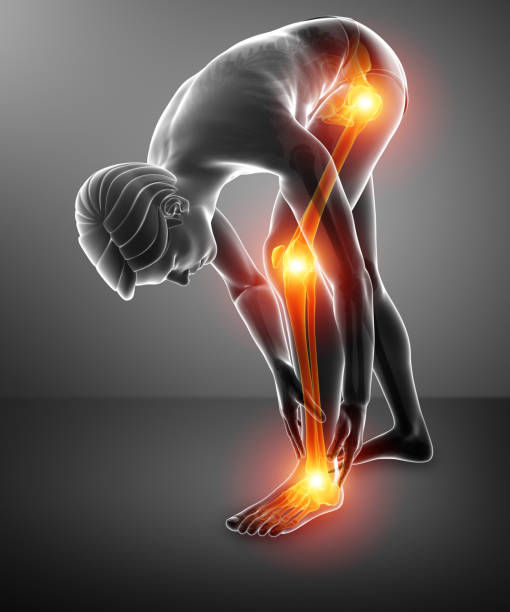Why Bone and Joint Support Is Essential for Your Health
Our bones and joints are the silent pillars of our body, supporting every move we make. Yet, most people don’t think about bone and joint health until pain or stiffness strikes. Supporting your bones and joints is not only important for mobility but also for long-term quality of life.
Healthy bones protect against osteoporosis, a condition where bones become weak and brittle. Strong joints ensure smooth movement and reduce the risk of arthritis, which affects millions worldwide. From standing up in the morning to climbing stairs or lifting groceries, bones and joints are always at work.
Unfortunately, factors like aging, poor diet, lack of exercise, obesity, and sedentary lifestyle weaken this system. Early signs such as joint stiffness, back pain, or frequent fractures should never be ignored.
By focusing on proper nutrition, physical activity, and preventive care, you can maintain stronger bones and flexible joints well into old age. Bone and joint support is not just about avoiding disease—it’s about living an active, independent, and pain-free life. The good news? Most bone and joint problems can be prevented with the right lifestyle choices.
Calcium and Vitamin D – The Power Duo for Bone Strength
When it comes to bone health, calcium and vitamin D are the two most important nutrients. Calcium is the primary building block of bones, while vitamin D helps the body absorb calcium efficiently. Without this power duo, bones become fragile and prone to fractures.
Calcium-rich foods include milk, yogurt, cheese, tofu, almonds, sesame seeds, and green leafy vegetables. But calcium alone isn’t enough—your body needs vitamin D to unlock its benefits. Vitamin D is produced naturally when your skin is exposed to sunlight. Foods such as salmon, eggs, and fortified cereals are also good sources.
Adults need around 1000–1200 mg of calcium per day and 600–800 IU of vitamin D depending on age. Unfortunately, deficiency is common, especially among people who spend little time outdoors or follow restrictive diets.
Low calcium and vitamin D levels can lead to osteopenia and osteoporosis, conditions where bones lose density and strength. To ensure strong bones, aim for a diet rich in these nutrients and consider supplements if prescribed by your doctor

Omega-3 Fatty Acids Natural Support for Joints
Strong bones are important, but healthy joints are equally vital for flexibility and pain-free movement. One of the most effective nutrients for joint support is omega-3 fatty acids. Found in fatty fish (like salmon, tuna, and mackerel), flaxseeds, walnuts, and chia seeds, omega-3s have powerful anti-inflammatory properties.
Joint pain often comes from inflammation in the cartilage—the tissue that cushions bones. Omega-3s reduce this inflammation, providing relief for people with arthritis and joint stiffness. They also help improve joint lubrication, making movements smoother and less painful.
Research shows that omega-3 fatty acids may slow the progression of rheumatoid arthritis, an autoimmune condition that attacks the joints. Regular intake can reduce morning stiffness, swelling, and the need for painkillers.
Supplements like fish oil capsules are popular, but natural food sources are always better. Aim for 2–3 servings of fatty fish per week or plant-based alternatives if you’re vegetarian.
By adding omega-3s to your diet, you not only support joint flexibility but also protect your heart, brain, and overall health—a win-win for your body
Which Exercises Are Most Effective for Strong Bones
Not all exercises are equal when it comes to bone health. The most effective workouts are weight-bearing and resistance exercises, which put healthy stress on bones, encouraging them to become denser and stronger.
Weight-bearing activities include walking, running, dancing, stair climbing, or hiking. These exercises force the bones to support your body weight, stimulating bone growth. Even a daily brisk walk of 30 minutes can significantly improve bone strength.
Resistance training (like lifting dumbbells, resistance bands, squats, or push-ups) builds muscle and strengthens bones at the same time. The extra pressure forces bones to adapt, making them more resilient against fractures.
Balance and flexibility exercises, such as yoga and Pilates, don’t directly increase bone density, but they reduce the risk of falls and injuries, which is equally important for bone protection.
The best routine combines all three types—weight-bearing, resistance, and flexibility training. Aim for at least 3–4 sessions per week, and make exercise a lifelong habit

Caring for Bones and Joints as You Age
As we grow older, our bones naturally lose density and joints may become stiff. Women after menopause are at higher risk due to hormonal changes, especially declining estrogen levels. But aging doesn’t have to mean fragile bones and painful joints—preventive care makes a huge difference.
Key strategies include:
- Maintain a nutrient-rich diet with calcium, vitamin D, protein, and omega-3s.
- Stay physically active with weight-bearing and balance exercises.
- Maintain a healthy weight, since excess body weight puts extra pressure on joints like knees and hips.
- Avoid smoking and excessive alcohol, both of which weaken bones.
Regular bone density scans (DEXA scans) after the age of 50 are recommended to monitor bone health. For joints, simple stretching and mobility exercises keep them lubricated and prevent stiffness.
By adopting these habits early, you can age with confidence, strength, and mobility. The key is to treat bone and joint support not as a cure but as a lifelong investment in your independence
Home Remedies to Prevent Joint Pain and Stiffness
While modern medicine offers treatments for joint issues, many people prefer natural remedies for daily support. Thankfully, several home remedies can ease joint stiffness and pain while boosting mobility.
- Turmeric (Curcumin): A natural anti-inflammatory spice that reduces joint swelling.
- Ginger: Improves circulation and lowers inflammation.
- Epsom Salt Soak: Magnesium-rich baths relax stiff joints and muscles.
- Warm Compresses: Increase blood flow and reduce stiffness.
- Cold Packs: Effective for sudden joint pain or swelling.
- Massage with essential oils (like eucalyptus or mustard oil) can improve flexibility.
Additionally, staying hydrated and practicing gentle yoga or stretching improves joint lubrication. A diet rich in antioxidants (fruits, vegetables, green tea) also fights inflammation naturally.
While these remedies are not substitutes for medical care, they are excellent supportive measures to maintain joint comfort in daily life
Lifestyle Habits to Prevent Arthritis and Osteoporosis
Bone and joint diseases like arthritis and osteoporosis don’t happen overnight—they are the result of years of lifestyle choices. The good news is, you can reduce your risk significantly with simple healthy habits.
- Balanced diet: Include calcium, vitamin D, and protein daily.
- Regular exercise: Weight-bearing activities strengthen bones; low-impact exercises protect joints.
- Quit smoking: Nicotine reduces blood flow to bones, slowing repair and growth.
- Limit alcohol: Excess alcohol interferes with calcium absorption.
- Maintain healthy posture: Prevents joint strain and spinal issues.
- Stay active daily: Sitting too long weakens muscles and stiffens joints.
Even small changes, like taking the stairs instead of elevators or doing 15 minutes of yoga daily, can have lasting effects. Prevention is always easier and more cost-effective than treatment.
By combining proper nutrition, physical activity, and healthy habits, you build a strong foundation for bone and joint health that lasts a lifetime.
SEO Keywords: arthritis prevention tips, osteoporosis natural prevention, lifestyle for bone health.
Foods That Harm Bones and Joints – What to Avoid
Just as some foods strengthen bones, others can silently weaken them. To keep your skeleton strong, limit these harmful items:
- Excess Salt: High sodium causes calcium loss through urine.
- Sugary Drinks & Sodas: Contain phosphoric acid that lowers bone density.
- Processed Foods: Lack nutrients and promote inflammation.
- Too Much Caffeine: Excess coffee or energy drinks reduce calcium absorption.
- Red and Processed Meat: Increases inflammation in joints.
- Alcohol: Weakens bones and damages liver function, interfering with nutrient absorption.
These foods may not harm you immediately but long-term overconsumption increases the risk of osteoporosis, arthritis, and chronic joint pain. Instead, focus on whole foods like fruits, vegetables, whole grains, nuts, and lean proteins.
Eating right isn’t just about avoiding disease—it’s about creating a diet that fuels strength, flexibility, and long-lasting energy
Do You Really Need Supplements for Bone and Joint Health
Many people wonder if supplements are necessary for strong bones and joints. The answer depends on your diet and lifestyle. Ideally, you should get nutrients like calcium, vitamin D, omega-3s, and protein from food. However, in today’s busy life, supplements can fill the gap.
- Calcium & Vitamin D tablets: Useful for people who don’t get enough from diet or sunlight.
- Glucosamine & Chondroitin: May help with joint lubrication and reduce arthritis pain.
- Collagen peptides: Support bone density and joint cartilage.
- Fish oil capsules: A convenient source of omega-3s.
Before starting supplements, consult your doctor, because unnecessary or excessive intake can cause side effects. For example, too much calcium may lead to kidney stones.
Supplements are not magic pills but can be effective add-ons when used responsibly along with diet and exercise. Think of them as backup support, not replacements for healthy living
Final Thoughts Strong Bones and Healthy Joints for Life
Bone and joint support is the foundation of a healthy, active, and independent life. From childhood to old age, our skeleton requires care, nourishment, and exercise to stay strong. Neglect leads to problems like arthritis, osteoporosis, stiffness, and fractures.
The good news is, prevention is in your hands. A balanced diet rich in calcium, vitamin D, protein, and omega-3s, regular weight-bearing exercise, and smart lifestyle choices can protect you. Avoid harmful foods, stay active, and practice mindfulness for overall wellness.
Remember, supplements can help, but they can never replace real food and physical activity. Whether you are in your 20s or 60s, it’s never too late to invest in your bone and joint health.
Stronger bones and flexible joints don’t just mean better health—they mean more freedom, confidence, and a higher quality of life. Support your bones today, and they will support you for a lifetime
Disclaimer
The tips and suggestions mentioned in this article are intended for general informational purposes only. Before starting any fitness program, making changes to your diet, or trying any remedies related to health conditions, please consult your doctor or a qualified healthcare professional. Dr. You does not verify or endorse the authenticity of any such claims made herein

